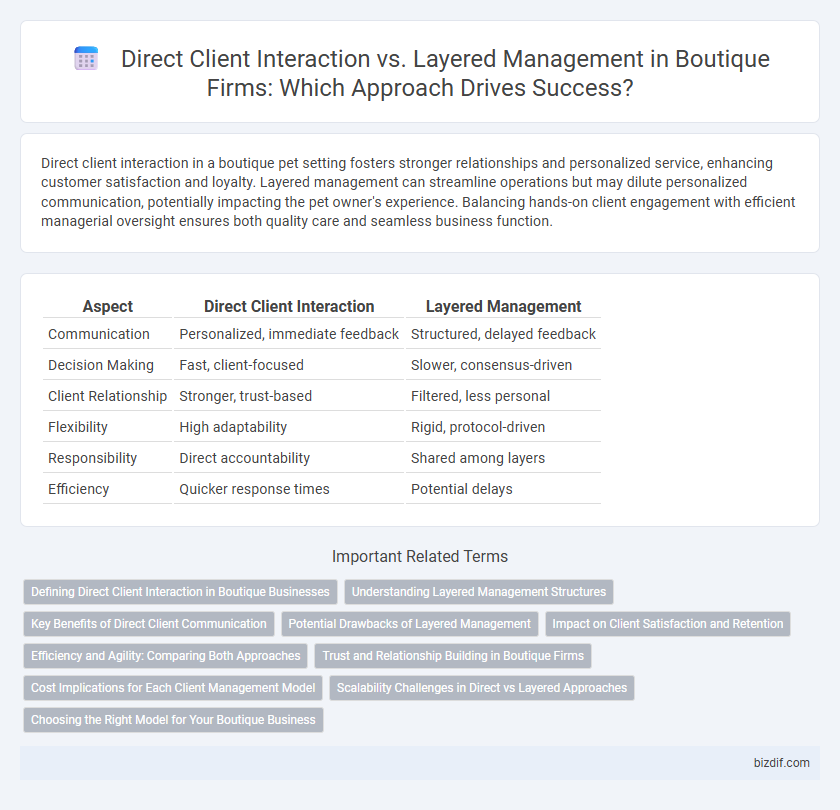Direct client interaction in a boutique pet setting fosters stronger relationships and personalized service, enhancing customer satisfaction and loyalty. Layered management can streamline operations but may dilute personalized communication, potentially impacting the pet owner's experience. Balancing hands-on client engagement with efficient managerial oversight ensures both quality care and seamless business function.
Table of Comparison
| Aspect | Direct Client Interaction | Layered Management |
|---|---|---|
| Communication | Personalized, immediate feedback | Structured, delayed feedback |
| Decision Making | Fast, client-focused | Slower, consensus-driven |
| Client Relationship | Stronger, trust-based | Filtered, less personal |
| Flexibility | High adaptability | Rigid, protocol-driven |
| Responsibility | Direct accountability | Shared among layers |
| Efficiency | Quicker response times | Potential delays |
Defining Direct Client Interaction in Boutique Businesses
Direct client interaction in boutique businesses involves personalized communication between service providers and clients, ensuring tailored solutions that meet specific needs. This approach fosters trust, enhances customer satisfaction, and allows for immediate feedback, which is crucial in industries like high-end retail, bespoke fashion, and specialized consulting. By minimizing layers of management, boutique firms maintain agility and a strong, client-focused culture that differentiates them from larger competitors.
Understanding Layered Management Structures
Layered management structures in boutique firms organize responsibilities across multiple hierarchical levels, ensuring clear accountability and specialized oversight. This approach contrasts with direct client interaction models by creating intermediary managers who filter client needs and streamline internal processes. Understanding these layers helps optimize communication flow and improves project delivery by aligning client expectations with team capabilities.
Key Benefits of Direct Client Communication
Direct client interaction in boutiques fosters personalized service, enabling immediate understanding of client needs and tailored solutions that enhance satisfaction and loyalty. This approach reduces miscommunication often caused by layered management, resulting in faster decision-making and project adjustments. Enhanced transparency and trust-building through direct dialogue contribute significantly to long-term client relationships and business growth.
Potential Drawbacks of Layered Management
Layered management in boutique firms often leads to communication delays and diluted client feedback, hindering personalized service quality. The increased hierarchy can create misunderstandings and slow decision-making, negatively impacting client satisfaction and responsiveness. This complexity may also distance top executives from direct client interaction, reducing opportunities for building strong relationships and tailoring solutions effectively.
Impact on Client Satisfaction and Retention
Direct client interaction in boutique firms enhances personalized service delivery, leading to higher client satisfaction and stronger retention rates by fostering trust and clear communication. Layered management can introduce delays and dilute client feedback, potentially reducing the responsiveness and customization that clients expect from boutique experiences. Prioritizing direct engagement allows boutiques to swiftly address client needs and build deeper, more loyal relationships.
Efficiency and Agility: Comparing Both Approaches
Direct client interaction in boutiques enhances efficiency by streamlining communication and accelerating decision-making, fostering agility through rapid feedback loops and personalized service. Layered management can slow response times due to hierarchical approval processes, but may offer structured oversight and risk mitigation. Balancing these approaches depends on the boutique's size and complexity, with direct interaction favoring nimble operations and layered management supporting scalability.
Trust and Relationship Building in Boutique Firms
Boutique firms prioritize direct client interaction, fostering trust through personalized communication and tailored services that are often lost in layered management structures. This hands-on approach strengthens client relationships by ensuring transparency, responsiveness, and deep understanding of client needs. By minimizing intermediaries, boutique firms create a more intimate and collaborative partnership that enhances loyalty and long-term engagement.
Cost Implications for Each Client Management Model
Direct client interaction in boutique firms typically reduces overhead costs by eliminating intermediary layers, leading to lower fees and increased client satisfaction. Layered management involves multiple levels of oversight, increasing operational expenses but potentially providing enhanced quality control and specialized expertise. Evaluating the cost implications, direct interaction models favor boutique firms aiming for lean operations, while layered management suits complex projects requiring structured supervision despite higher costs.
Scalability Challenges in Direct vs Layered Approaches
Direct client interaction in boutique settings fosters personalized service but limits scalability due to resource-intensive demands on senior staff. Layered management structures enable delegation and broader client reach, enhancing scalability by distributing responsibilities across tiers. However, this approach risks diluting client relationships and requires robust communication protocols to maintain service quality.
Choosing the Right Model for Your Boutique Business
Direct client interaction fosters personalized service and swift decision-making, enhancing customer satisfaction and loyalty in boutique businesses. Layered management introduces structured processes and specialized roles, improving scalability and operational efficiency as the boutique grows. Selecting the ideal model depends on business size, client expectations, and long-term growth objectives.
Direct Client Interaction vs Layered Management Infographic

 bizdif.com
bizdif.com